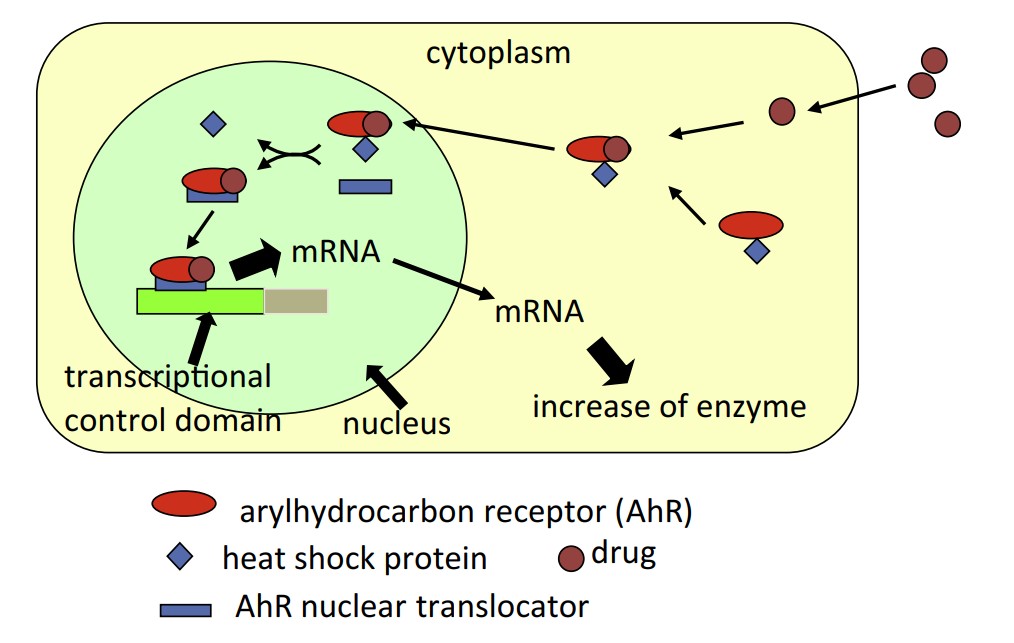Enzyme Induction Assessment Service
Enzyme induction assays are important in the prediction of drug-drug interactions that may occur in vivo, which can significantly affect the safety and efficacy of drugs. At Creative Biolabs, we utilize physiologically relevant systems like primary human hepatocytes to predict whether a drug may affect the metabolism of other drugs metabolized by key enzymes, leading to potential drug-drug interactions. By measuring the activity of these enzymes, such as CYP450 and UGT enzymes involved in phase I and phase II drug metabolism, we can assess whether the test drugs have the potential to induce changes in enzyme activity.
 Fig.1 Mechanism of CYP1A induction drug in hepatocytes cytoplasm.1
Fig.1 Mechanism of CYP1A induction drug in hepatocytes cytoplasm.1
Enzyme Induction Assays
Enzyme induction assays are essential for predicting and understanding the metabolism-dependent drug-drug interactions that can occur between drugs. To assess enzyme induction assays, hepatocytes are incubated with test drugs suspected of inducing the upregulation of enzymes. By measuring the activity of these enzymes, we assess whether the test compound has the potential to induce changes in enzyme activity. Furthermore, gene expression levels of specific isozymes can be determined using molecular techniques such as quantitative real-time polymerase chain reaction (qRT-PCR).
The CYP induction assay is a commonly used assay to evaluate the potential of drugs to induce CYP enzymes. In the CYP induction assay, hepatocytes are incubated with the test drugs. By comparing the CYP enzyme activity in hepatocytes incubated with the test drug to that in control hepatocytes, the potential of the test drug to induce CYP enzyme upregulation can be assessed. Additionally, gene expression levels of specific CYP isozymes can be determined using qRT-PCR, providing further insight into the mechanism of enzyme induction.
|
Test System
|
Fresh human hepatocytes or cryopreserved human hepatocytes
|
|
CYP Enzymes
|
CYP1A, CYP2B6, CYP2C8, CYP2C9, CYP2C19, CYP3A4, etc.
|
|
Concentrations
|
Multiple concentrations of test articles are available. We recommend 6 concentrations.
|
|
Number of Replicates
|
3
|
|
Analysis Method
|
-
Analysis of enzyme catalytic activity of CYP isoforms via LC-MS/MS
-
Analysis of relative mRNA levels expression by qRT-PCR
|
In addition to CYP enzymes, UGT enzymes also play a crucial role in drug metabolism. We offer UGT induction assay as well.
|
Test System
|
Fresh human hepatocytes or cryopreserved human hepatocytes
|
|
UGT enzymes
|
UGT1A1, UGT1A4, UGT1A6, UGT1A9, UGT2B, etc.
|
|
Concentrations
|
Multiple concentrations of test articles are available. We recommend 6 concentrations.
|
|
Number of Replicates
|
3
|
|
Analysis Method
|
-
Analysis of enzyme catalytic activity of UGT isoforms via LC-MS/MS
-
Analysis of relative mRNA levels expression by qRT-PCR
|
Reference
-
Sasaki, Kazuaki, and Minoru Shimoda. "Possible drug–drug interaction in dogs and cats resulted from alteration in drug metabolism: A mini review." Journal of Advanced Research 6.3 (2015): 383-392.
For Research Use Only | Not For Clinical Use


 Fig.1 Mechanism of CYP1A induction drug in hepatocytes cytoplasm.1
Fig.1 Mechanism of CYP1A induction drug in hepatocytes cytoplasm.1
 Download our brochure
Download our brochure